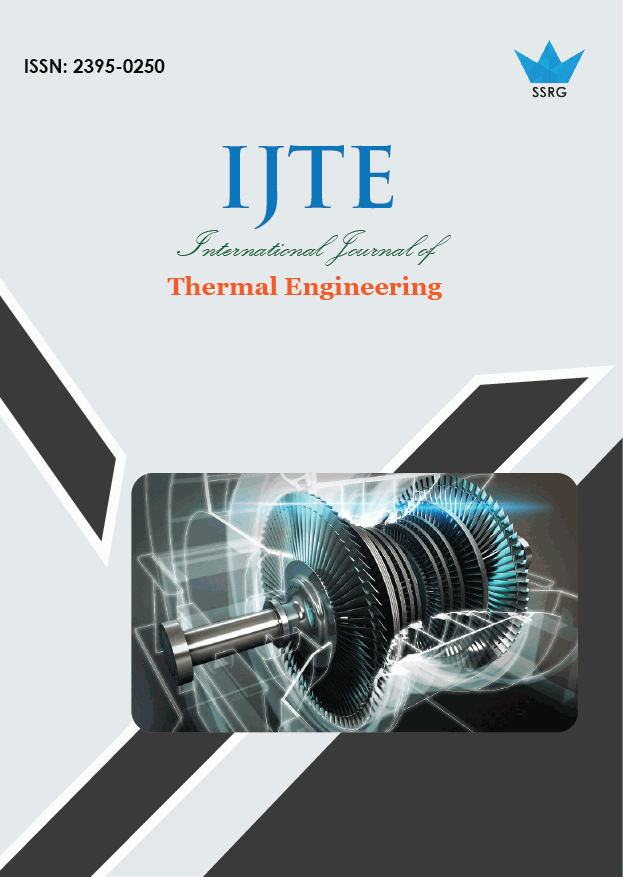Study of Ocean Thermal Energy Conversion Power Plant

| International Journal of Thermal Engineering |
| © 2015 by SSRG - IJTE Journal |
| Volume 1 Issue 2 |
| Year of Publication : 2015 |
| Authors : S. Balakumar, C. Sathivel |
How to Cite?
S. Balakumar, C. Sathivel, "Study of Ocean Thermal Energy Conversion Power Plant," SSRG International Journal of Thermal Engineering, vol. 1, no. 2, pp. 22-26, 2015. Crossref, https://doi.org/10.14445/23950250/IJTE-V1I3P102
Abstract:
The usage of organic isobutane will be explored for a closed-cycle Ocean Thermal Energy conversion (OTEC) on-shore plant that delivers 110 MW electric powers. This paper will shieldthe concept, process, energy calculations, cost factoids and conservational aspects. In isobutane cycle, hot ocean surface water is used to evaporate and to superheat isobutane in a heat exchanger. Isobutane vapor then expands through a turbine to produce useful power. The exhaust vapor is summarized afterwards, using the cold deeper ocean water, and impelled to a heat exchanger to complete a cycle. Results show the major design characteristics and equipment's of the OTEC plant along with cycle effectiveness and cycle improvement techniques.
Keywords:
Ocean Thermal Engineering Conversion (OTEC); isobutene; thermal plant; energy convergence.
References:
[1] Ghenai, G., Energy-Water-Carbon Interconnection: Challenges and Sustainable Solutions Methods and Strategies. Int. J. of Thermal & Environmental Engineering Volume 7, No 2 (2014) 57-64. DOI:10.5383/ijtee.04.02.001
[2] Aswathanarayana, U., Harikrishnan T., Sahini K.,Green Energy Technology: Economics and Policy. Int. J.Taylor & Francis Group, London, UK 2010.
[3] Gritton, E., Pei R., Aroesty J., Balaban M., Gazley C.,Hess R. and Krase W., A Quantitative Evaluation of Closed-Cycle Ocean Thermal Energy Conversion (OTEC)
in Central Station Applications: Prepared for US Department of Energy, Government of USA, 1980.
[4] Tchanche B. F., Papadakis G., Lambrinos G., and Frangoudakis A., Criteria for Working Fluids Selection in Low-Temperature Solar Organic Rankin Cycles: Proceedings of Eurosun Conference, Lisbon, Portugal, Oct. 7–10., 2008.
[5] Gong, J., Gao, T., Li, G., Performance Analysis of 15kW Closed Cycle Ocean Thermal Energy Conversion System With Different Working Fluids: Journal of Solar Energy Engineering, (135), pp. 024501, 2012.
[6] Balabel, A. and Kotb, H., Analysis of a Hybrid Renewable Energy Stand-Alone Unit for Simultaneously Producing Hydrogen and Fresh Water from Sea Water: Int. J. of Thermal & Environmental Engineering Volume 6, No.2 (2013) 55-60. DOI: 10.5383/ijtee.06.02.002
[7] Goodbody, E., and Thomas-Hope, E., Natural ResourceManagement for Sustainable Development in the Caribbean: Canoe Press, 2002. SSRG International Journal of Thermal Engineering (SSRG-IJTE) volume 1 Issue3 May to June 2015 ISSN: 2395 – 0250 www.internationaljournalssrg.org Page 12
[8] Seymour, R., Ocean Energy Recovery: The State of the Art. ASCE Publications, 1992.
[9] Bucker D. and Wagner W., Reference Equations of State for the Thermodynamic Properties of Fluid Phase nButane and Isobutane: J. Phys. Chem. Ref. Data, Vol. 35,
No. 2, 2006.
[10] TRW Energy Development Group, GEOTEC Engineering Concept Study Prepared for Naval Weapons Centre: Government of USA, 1984.
[11] Wikipedia. Material properties and characteristics and equipment specifications: www.wikipedia.com, 2013.
[12] Vega L., First Generation 50 MW OTEC Plant-ship for the Production of Electricity and Desalinated Water: Offshore Technology Conference OTC 20957, USA., 2010.
[13] Wu C. Thermodynamics and Heat Powered Cycles: A Cognitive Engineering Approach, Nova Science Publishers, Inc. New York, USA. 2007.
[14] Finney, Ocean Thermal Energy Conversion: Guelph Guelph Engineering Journal, (1), pp.17 - 23, 2008.

 10.14445/23950250/IJTE-V1I3P102
10.14445/23950250/IJTE-V1I3P102